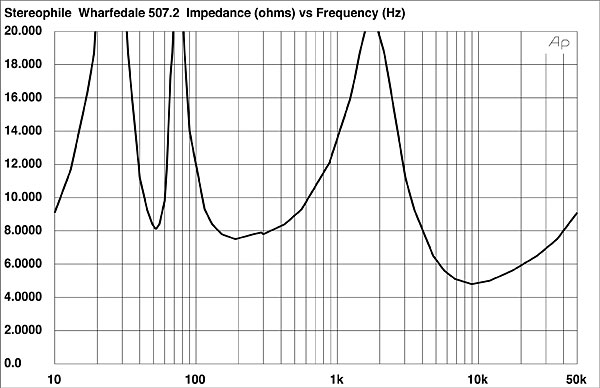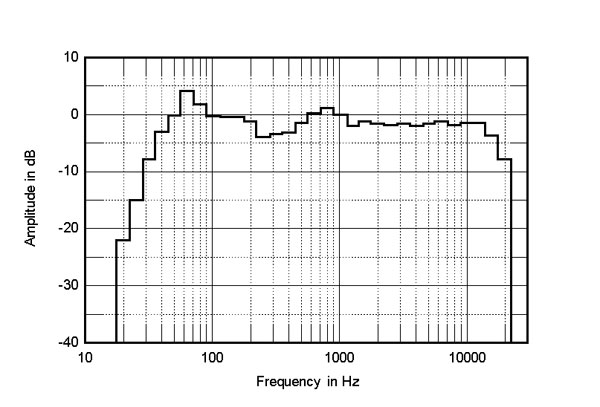| Columns Retired Columns & Blogs |
Yikes:-)
Looking at the way in which the 507.2's impedance changes with frequency (fig.1; measured with spot tones but plotted with the Audio Precision System One software), the port is tuned to 52Hz, which suggests moderate LF extension. This was confirmed by the nearfield measurement which, without taking the output from the port into consideration, indicated a –6dB point at 62Hz. Though typical of an 8 ohm design in the woofer region, the tweeter is undoubtedly a 4 ohm unit. This is presumably to get sufficient sensitivity from a ¾" dome, which has significantly less radiating area than the ubiquitous 1" metal-dome unit. The smaller dome diameter, however, does make it easier to push the "oil-can" resonant mode up away from the audio band. This resonance of the Wharfedale tweeter is said to lie at 37kHz. The high crossover frequency of 5kHz also implies that the tweeter has little in the way of power-handling capacity, though this also means that it is operating nearly two octaves above its own resonant frequency.

The cabinet seemed pretty dead in the midrange, but I did note two frequencies where its walls vibrated: 345Hz and 250Hz, the lower being particularly strong. (Interestingly, Martin Colloms noted a second-harmonic distortion peak at this frequency in the November 1988 issue of Hi-Fi News & Record Review.) Putting an ear to the cabinet sides with pink noise playing did reveal a strong "warble" around middle C (262Hz).
The frequency response of the speakers was measured in the listening area using pink noise and an Audio Control SA-3050A 1/3-octave spectrum analyzer. Nine sets of six averaged measurements were taken independently for left and right loudspeakers in a window 72" wide and varying from 27" to 45" high. The response shown in each review is the average of these measurements, weighted slightly toward the sound heard at the listening position. This spatial averaging is intended to minimize the effect of room standing-wave problems on the measurement and gives a response curve that has proved to correlate reasonably well with what is perceived; it also gives an idea of the off-axis behavior of the speaker under test.
In-room and spatially averaged (fig.2), the treble is about the flattest I have ever measured, ±0.4dB limits sufficing from 1.6kHz to 12.5kHz, though conspicuously lacking is the expected hump in the presence region due to the HF unit's effectively hemispherical dispersion in this region. The woofer must be operating well into breakup in the top two octaves of its range, which may well help match its directivity with that of the tweeter at crossover. Below this band, however, can be seen a moderate rise centered on 800Hz, which probably correlates with the forward midrange balance noted.

Somewhat unusually, compared with the other speakers I have reviewed, the response in-room on-axis from the lower midrange (500Hz) up was within ±0.5dB between channels. This excellent pair matching indicates good quality control on Wharfedale's part.
The fact that the 507.2 has a smaller box volume than the Spectrum 208B that I also review in this issue can be seen in the fact that it starts to roll off 20Hz earlier in the bass. You just can't beat a big box for low-frequency extension (though, as Dick Olsher points out in his subwoofer review in this issue, larger boxes do have larger problems, particularly in the midband). The low frequencies seem from the curve to be a little underdamped, which would indicate that placing these speakers near the rear wall to take advantage of low-bass boundary reinforcement would not be a good idea.
The set of responses taken from a 45" microphone distance show a dip developing in the region around crossover, from 4–8kHz; in fact, the optimum axis seems to be level with the tweeter, which is rather a low listening height with the speakers on 17" stands; 20" stands would be a better match, given the typical height from the floor of a listener's ears of around 36". Measured sensitivity with pink noise was apparently the same as the much larger Spectrum 208B at around 89dB/W/m, but this discrepancy is accounted for by the lower average impedance of the Wharfedale, the speaker sucking more than 1W from the amplifier at the 2.83V input level. Assuming a 6 ohm nominal impedance, this figure will drop to around 87dB/W/m; ie, right on spec.—John Atkinson

Yikes:-)